Numark Industries NS7II User Manual

User Guide
English ( 3 – 14 )
Guía del usuario
Español ( 15 – 26 )
Guide d'utilisation
Français ( 27 – 38 )
Guida per l'uso
Italiano ( 39 – 50 )
Benutzerhandbuch
Deutsch ( 51 – 62 )
Appendix
English ( 63 )
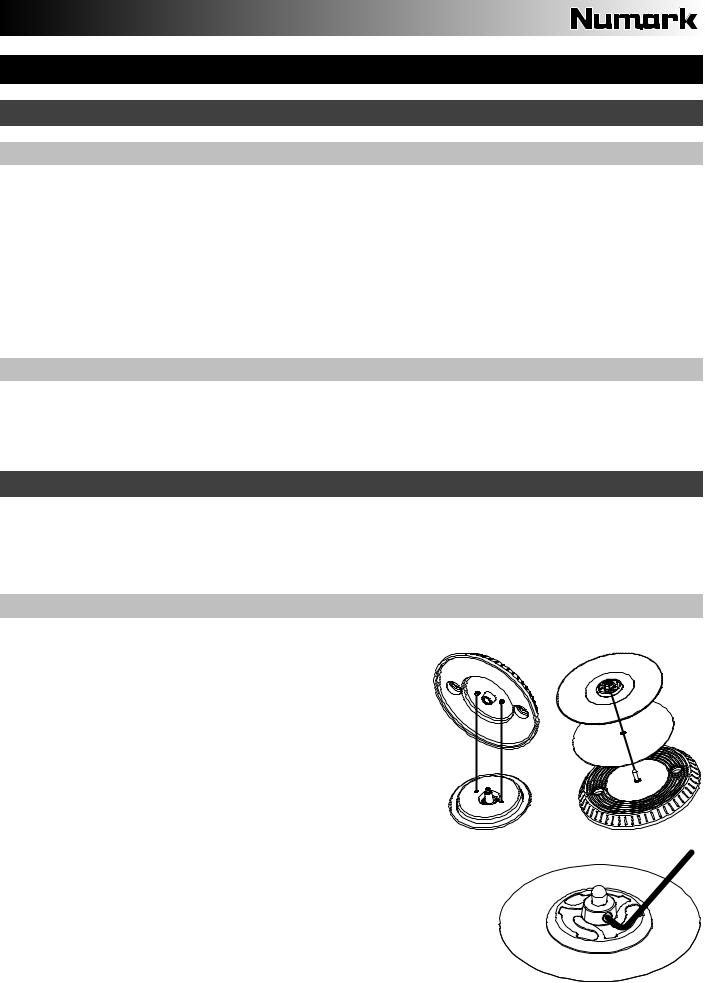
User Guide (English)
Introduction
Box Contents
•NS7II
•2 Platter Assemblies:
o Aluminum Platter
o Slipmat
o Vinyl
o45 RPM Adapter (attached)
•IEC Power Cable
•USB Cable
•Spindle Screw
•Allen Wrench
•Serato DJ software (download)
•Quickstart Guide
•User Guide
•Safety & Warranty Manual
Product Registration and Support
For the latest information about this product (system requirements, compatibility information, etc.) and product registration, visit numark.com/ns7ii.
For additional product support, visit numark.com/support.
Quick Start
BEFORE GETTING STARTED:
•Read the Safety & Warranty Manual before using the NS7II.
•Make sure all items listed in the Box Contents are included.
1. Assemble the Platters
1. Remove the NS7II from the packaging. Remove the two |
Step 2 |
|
|
platter assemblies from package (underneath the NS7II |
|
controller). Place the NS7II is on a flat, stable surface for |
|
operation. Ensure unit has adequate air flow to all ventilation |
|
ports (especially if installed in a case). |
|
2.Place the platter onto the NS7II by aligning the pins in the bottom of the platter with the holes in the NS7II's motor.
3. Place the slipmat onto the platter, then place the vinyl over the slipmat.
4.Line up the notch in the spindle with the screw in the vinyl's 45 RPM Adapter. Use the allen wrench (included) to tighten the screw, locking the adapter to the spindle.
Step 3
Step 4
3
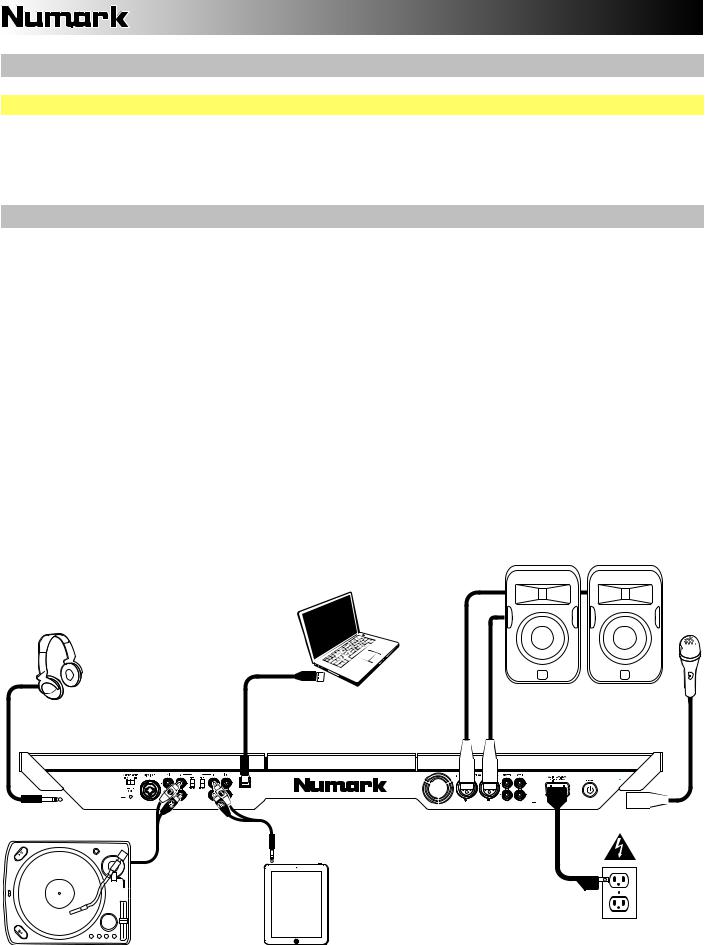
2. Install the Drivers and Software
IMPORTANT: Install the drivers before installing the software.
Drivers: Download and install the latest drivers from numark.com/ns7ii. (You will be asked to connect the NS7II to your computer during installation.)
Software: Download and install the latest version of Serato DJ from serato.com.
3. Connect and Start DJing!
Follow this sequence of steps whenever you use NS7II:
1.Make sure all devices are off and all faders and gain knobs are set to "zero."
2.Connect input sources (microphones, turntables, CD players, etc.) to the NS7II.
3.Connect output devices (power amplifiers, sub-mixer, recorders, etc.) to the NS7II.
4.Plug all devices into power sources, and turn on devices in proper order:
•When starting a session, turn on (1) input sources, (2) NS7II, (3) output devices.
•When ending a session, turn off (1) output devices, (2) NS7II, (3) input sources.
5.Connect the NS7II to your computer with the USB cable (included) and to your headphones.
6.Open Serato DJ and go! For more information on how to use Serato DJ with NS7II, visit serato.com/dj/support and select Numark NS7II.
Connection Diagram (example):
Powered Loudspeakers
Computer
Headphones
(to front panel)
Microphone
(to front panel)
|
00.0% |
|
Power |
Turntable |
Tablet, MP3 player, etc. |
Any items shown here but not mentioned in the Box Contents are sold separately.
4

Features |
|
|
|
|
|
|
|
|
|
|
|
|
|
|
|
|
|
|
|
|
|
|
|
|
|||
Top Panel |
|
|
|
|
|
|
|
|
|
|
|
|
|
|
|
|
|
|
|
|
|
|
|
|
|||
|
|
31 |
|
|
50 |
50 |
50 |
52 |
|
42 |
|
41 |
|
42 |
|
50 |
50 |
|
50 |
|
52 |
|
|
31 |
|
|
|
|
|
|
|
15 |
|
|
|
|
14 |
|
|
|
|
|
|
|
|||||||||||
|
|
|
|
|
|
|
|
|
|
|
|
|
|
|
|
|
|
|
|
|
|
|
|
|
|
||
|
|
|
|
|
|
|
|
|
|
|
43 |
44 |
|
45 |
|
|
|
|
|
|
|
|
|
|
|
|
|
35 |
ADJUST |
SLIP |
|
49 |
49 |
49 |
51 |
|
|
|
|
|
53 |
|
49 |
49 |
49 |
51 |
|
|
ADJUST |
SLIP |
35 |
||||
33 |
32 |
|
|
|
|
|
|
|
PANEL |
46 |
47 |
|
|
|
|
|
|
|
|
|
|
33 |
32 |
||||
|
SET |
CLEAR |
|
|
|
|
|
|
|
48 |
|
46 |
|
|
|
|
|
|
|
|
|
SET |
CLEAR |
|
|||
|
17 |
|
|
|
|
|
|
|
|
|
|
|
|
|
|
|
|
|
|
|
|
17 |
|
||||
|
|
|
|
|
|
|
|
|
|
|
|
|
|
|
|
|
|
|
|
|
|
|
|
|
|
||
|
|
18 |
|
|
|
|
|
|
1 |
53 |
|
53 |
40 |
53 |
53 |
|
1 |
|
|
|
|
|
|
|
18 |
|
|
|
|
|
|
|
|
|
|
|
|
|
|
|
|
|
|
|
|
|
|
|
|
|
|
|
|
||
22 |
|
|
|
|
|
|
|
|
|
|
|
|
|
|
|
|
|
|
|
|
|
|
|
|
|
|
22 |
|
|
|
|
|
|
|
|
|
|
6 |
|
6 |
|
6 |
6 |
|
|
|
|
|
|
|
|
|
|
|
|
SLIP |
|
|
|
|
|
|
|
|
TOUCH |
|
|
|
|
|
|
|
FILTER ROLL |
|
|
|
|
|
|
|
|
|
SLIP |
MODE |
|
|
|
|
|
|
|
|
|
|
|
|
|
|
|
|
|
|
|
|
|
|
|
|
MODE |
||
34 |
|
|
|
|
|
|
|
|
2 |
8 |
|
8 |
|
8 |
8 |
|
55 |
|
|
|
|
|
|
|
|
|
34 |
|
|
|
|
|
|
|
|
|
TOUCH LOCK |
7 |
7 |
|
7 |
|
7 |
7 |
|
|
|
|
|
|
|
|
|
|
|
36 |
|
|
|
|
16 |
|
|
|
23 |
9 |
|
9 |
|
9 |
9 |
|
23 |
|
|
|
|
16 |
|
|
|
|
36 |
|
|
|
|
|
|
|
|
|
|
|
|
|
|
|
|
|
|
|
|
|
|
|
|
||||
|
|
|
|
|
|
|
|
|
|
|
|
|
|
|
|
|
|
|
|
|
|
|
|
|
|
||
|
|
|
|
|
|
|
|
|
23 |
10 |
|
10 |
|
10 |
10 |
|
23 |
|
|
|
|
|
|
|
|
|
|
|
|
|
|
|
|
|
|
|
|
|
|
|
4 |
|
|
|
|
|
|
|
|
|
|
|
|
|
|
|
|
|
|
|
|
|
|
|
23 |
|
|
|
|
|
|
|
23 |
|
|
|
|
|
|
|
|
|
|
|
|
|
|
|
|
|
|
|
|
54 |
|
54 |
|
54 |
54 |
|
|
|
|
|
|
|
|
|
|
|
|
|
37 |
|
|
|
|
|
|
23 |
|
5 |
|
5 |
|
5 |
5 |
23 |
|
|
|
|
|
|
|
37 |
|
||
|
|
|
|
|
|
|
|
|
23 |
12 |
12 |
|
12 |
|
12 |
|
23 |
|
|
|
|
|
|
|
|
|
|
|
37 |
3 |
|
|
|
|
3 |
|
11 |
|
11 |
|
11 |
11 |
|
|
3 |
|
|
|
|
|
3 |
37 |
|
||
|
|
|
|
|
|
|
|
|
|
|
|
|
|
|
|
|
|
|
|
||||||||
|
|
|
26 |
27 |
28 |
29 |
30 |
|
|
|
|
|
|
|
|
|
|
|
26 |
27 |
28 |
29 |
30 |
|
|
|
|
|
|
|
|
|
|
|
|
|
21 |
|
|
|
|
|
|
|
21 |
|
|
|
|
|
|
|
|
|
|
|
|
|
|
|
|
|
|
|
SYNC OFF |
|
|
|
|
|
|
|
SYNC OFF |
|
|
|
|
|
|
|
|
|
|
38 |
25 |
|
|
|
|
|
|
|
|
|
|
|
|
|
|
|
|
|
|
|
|
|
|
|
|
25 |
38 |
|
|
|
24 |
24 |
|
24 |
24 |
|
20 |
|
|
|
|
|
|
|
20 |
|
24 |
|
24 |
|
24 |
24 |
|
|
|
|
25 |
|
|
|
|
|
|
|
|
|
|
|
|
|
|
|
|
|
|
|
|
|
|
|
|
25 |
|
|
|
|
24 |
24 |
|
24 |
24 |
|
19 |
|
|
|
|
|
|
|
19 |
|
24 |
|
24 |
|
24 |
24 |
|
|
|
|
|
|
|
|
|
|
|
|
|
|
|
|
13 |
|
|
|
|
|
|
|
|
|
|
|
|
||
|
|
|
|
|
|
|
|
|
|
|
|
|
|
|
|
|
|
|
|
|
|
|
|
|
|
|
|
39 |
39 |
|
|
|
|
|
|
STUTTER |
|
|
|
|
|
|
|
STUTTER |
|
|
|
|
|
|
|
39 |
39 |
||
Useful Terms:
Audio Pointer: The current position in a track from where audio will play. When you select a track and begin playing, the Audio Pointer will usually start from the beginning and stop at the end.
Hot Cue Point: A marked position in a track, which will be permanently stored by the software.
You can set, return to, or delete Hot Cue Points with the Hot Cue Buttons.
Temporary Cue Point: A marked position in a track, which will only remain while that track is still loaded in the Deck. You can set and return to the Temporary Cue Point with the Cue button.
General Controls
1.Shift: Press and hold this button to access secondary functions (in red lettering) of other controls on NS7II.
2.Touch Mode: Press and hold this button to activate Touch Mode, which lets you access the touch-capacitive functions of NS7II's FX 1 Knob, FX 2 Knob, and FX 3 Knob.
Press and hold Shift and then press this button to access the touch-capacitive functions of the same knobs as above plus the EQ Knobs (Channel Treble, Channel Mid, and Channel Bass). These functions are momentary, not "latching."
3.Layer: Selects which Layer in the software is controlled by that hardware Deck. Deck A can control Layer 1 or 3; Deck B can control Layer 2 or 4.
4.USB Indicator: This LED lights up when NS7II is successfully connected to and communicating with your computer.
5

Mixer Controls
5.Input Selector: Set this switch to the desired audio source from this channel: PC (a track playing on that layer in the software), Mic 2 or Line (a device connected to the Mic 2 Input or Line Input on NS7II's rear panel). Please note that the Line/Phono selector switches on
NS7II's rear panel must also be set properly. Also, a channel's controls will only send MIDI information when its Input Selector is set to PC.
Important: Do not set more than one channel's Input Selectors to Mic2; doing so can cause unwanted feedback or distortion.
6.Gain Trim: Adjusts the pre-fader, pre-EQ audio level of the corresponding channel in the software.
7.LED Meters: Monitors the audio levels of the corresponding channel.
8.Channel Treble: Adjusts the high (treble) frequencies. When Touch Mode is activated, touching this knob will mute the corresponding channel's high frequencies (an "EQ kill").
9.Channel Mid: Adjusts the mid-range frequencies. When Touch Mode is activated, touching this knob will mute the corresponding channel's mid-range frequencies (an "EQ kill").
10.Channel Bass: Adjusts the low (bass) frequencies. When Touch Mode is activated, touching this knob will mute the corresponding channel's low frequencies (an "EQ kill").
11.Channel Fader: Adjusts the audio level on the corresponding channel in the software.
12.PFL: Press this button to send this channel's pre-fader signal to the Cue Channel for monitoring. When engaged, the button will be lit. By pressing one PFL button at a time, you will cue that channel alone (and deactivate PFL monitoring for the other channels). To cue to multiple channels simultaneously, press the PFL buttons for those channels at the same time.
13.Crossfader: Blends audio between the channels assigned to the left and right side of the crossfader.
14.Master Volume: Adjusts the output volume of the Program Mix.
15.Booth/Zone Volume: Adjusts the output volume of the Booth Output mix.
Playback Controls
16.Platter: Controls the Audio Pointer in the software.
17.Start Time: Controls the rate at which the platter regains its normal playback speed.
18.Stop Time: Controls the rate at which the platter slows to a complete stop ("brake time").
19.Play / Pause: This button pauses or resumes playback.
Press and hold Shift and then press this button to "stutter-play" the track from the last set Cue Point.
20.Cue: When the Deck is paused, you can set a Temporary Cue Point by moving the Platter to place the Audio Pointer at the desired location and then pressing the Cue Button.
During playback, you can press the Cue Button to return the track to this Temporary Cue Point. (If you did not set a Temporary Cue Point, then it will return to the beginning of the track.)
6

If the Deck is paused, you can press and hold the Cue Button to play the track from the Temporary Cue Point. Releasing the Cue Button will return the track to the Temporary Cue Point and pause it. To continue playback without returning to the Temporary Cue Point, press and hold the Cue Button, then press and hold the Play Button, and then release both buttons.
Press and hold Shift and then press this button to return to the beginning of the track.
21.Sync: Press this button to automatically match the corresponding Deck's tempo with the opposite Deck's tempo and phase. Press and hold Shift and press this button to deactivate Sync.
22.Bleep / Reverse: Reverses audio playback of the track on the corresponding deck.
When the switch is in the Reverse position, the playback of the track will be reversed.
Returning the switch to its center (deactivated) position will resume normal playback from wherever the Audio Pointer stops.
When the switch is in the Bleep position, the playback of the track will be reversed. Returning the switch to its center (deactivated) position will resume normal playback from where it would have been if you had never engaged the Bleep function (i.e., as if the track had been playing forward the whole time).
Cue Controls
23.Hot Cue Buttons (1-5): Assigns a Hot Cue Point or returns the track to that Hot Cue Point.
When a Hot Cue Button is unlit, you can assign a Hot Cue Point by pressing it at the desired point in your track. Once it is assigned, the Hot Cue Button will light. To return to that Hot
Cue Point, simply press it.
Press and hold Shift and then press a Hot Cue Button to delete its assigned Hot Cue Point.
Tip: If the Deck is paused, holding a lit Hot Cue Button will start playback from that Hot Cue
Point. Releasing it will return the track to that Hot Cue Point and pause playback.
Pad Mode Controls
24.Pads: These pads have different functions on each Deck depending on the current Pad
Mode. These pads are the same pads used with Akai Professional MPCs, so they are velocity-sensitive (in certain modes only), durable, and easy to play.
In this section, when referring to specific pads, it will refer to the numbers as shown in the diagram on the right.
1 


 2
2 


 3
3 


 4
4
5 


 6
6 


 7
7 


 8
8
25.Parameter < / > : Use these buttons for various functions in each Pad Mode (described below).
7
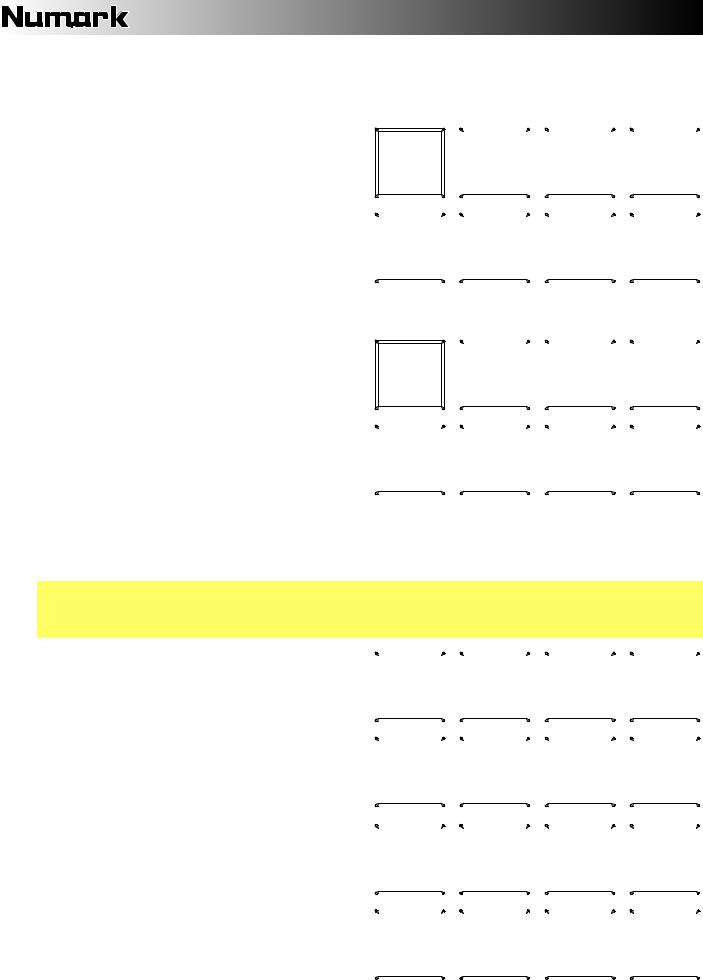
26.Cues: This Pad Mode button switches the pads between two modes: Hot Cue Mode (red) and Hot Cue Auto-Loop Mode (orange). When the button is unlit, the first press will always select Hot Cue Mode.
•Hot Cue Mode: Each pad assigns a Hot
Cue Point or returns the track to that Hot
Cue Point. (Pads 1-5 are essentially |
Hot Cue 1 |
|
|
||
duplicates of Hot Cue Buttons 1-5). |
|
|
When a Hot Cue Button is unlit, you can |
|
|
assign a Hot Cue Point by pressing it at |
|
|
|
|
|
the desired point in your track. Once it is |
|
Hot Cue 5 |
assigned, the Hot Cue Button will light. |
|
|
|
|
|
Press and hold Shift and then press a |
|
|
|
|
|
pad to delete its assigned Hot Cue Point. |
|
|
•Hot Cue Auto-Loop Mode: Each pad
assigns a Hot Cue Point or returns the |
Hot Cue 1 + |
track to that Hot Cue Point, but in both |
Auto-Loop |
cases, it also creates an Auto-Loop at |
|
that point. The Auto-Loops length is set |
|
|
|
in the software, but you can decrease or |
|
increase it with the Parameter < or |
Hot Cue 5 + |
Parameter > button. |
Auto-Loop |
|
|
|
|
|
Hot Cue 2 |
|
|
Hot Cue 3 |
|
|
|
Hot Cue 4 |
|
|
|
|
|
|
|
|
|
|
|
|
|
|
|
|
|
|
|
|
|
|
Hot Cue 6 |
|
|
Hot Cue 7 |
|
|
Hot Cue 8 |
|
|
|
|
|
|
|
|
|
Hot Cue 2 + |
|
|
Hot Cue 3 + |
|
|
|
Hot Cue 4 + |
|
|
Auto-Loop |
|
|
Auto-Loop |
|
|
|
Auto-Loop |
|
|
|
|
|
|
|
|
|
|
|
|
|
|
|
|
|
|
|
|
|
|
Hot Cue 6 + |
|
|
Hot Cue 7 + |
|
|
Hot Cue 8 + |
|
Auto-Loop |
|
|
Auto-Loop |
|
|
Auto-Loop |
|
|
|
|
|
|
|
|
27.Auto / Roll: This Pad Mode button puts the pads in two modes: Auto-Loop Mode (dark blue) and Loop Roll Mode (light blue). When the button is unlit, the first press will always select
Auto-Loop Mode.
Note: The pad layouts here match the software's default Auto-Loop time division layout. If you shift the range of time divisions displayed in the software, the pad layout will change to match it.
•Auto-Loop Mode: Each pad triggers or
releases an Auto-Loop of a different length. Press and hold Shift and then press the Parameter < or Parameter > button to shift the Auto-Loop backward or forward.
•Loop Roll Mode: Each pad triggers a
momentary Loop Roll. Press the Parameter < or Parameter > button to change the Loop Roll's time division.
|
1/8-beat |
|
|
1/4-beat |
|
|
1/2-beat |
|
|
|
1-beat |
|
|
Auto-Loop |
|
|
Auto-Loop |
|
|
Auto-Loop |
|
|
|
Auto-Loop |
|
|
|
|
|
|
|
|
|
|
|
|
|
|
|
|
|
|
|
|
|
|
|
|
|
|
|
|
2-beat |
|
|
4-beat |
|
|
8-beat |
|
|
16-beat |
|
Auto-Loop |
|
|
Auto-Loop |
|
|
Auto-Loop |
|
|
Auto-Loop |
|
|
|
|
|
|
|
|
|
|
|
|
|
|
|
|
|
|
|
|
|
|
|
1/8-beat |
|
|
1/4-beat |
|
|
1/2-beat |
|
|
|
1-beat |
|
|
Loop Roll |
|
|
Loop Roll |
|
|
Loop Roll |
|
|
|
Loop Roll |
|
|
|
|
|
|
|
|
|
|
|
|
|
|
|
|
|
|
|
|
|
|
|
|
|
|
|
|
2-beat |
|
|
4-beat |
|
|
8-beat |
|
|
16-beat |
|
Loop Roll |
|
|
Loop Roll |
|
|
Loop Roll |
|
|
Loop Roll |
|
|
|
|
|
|
|
|
|
|
|
8
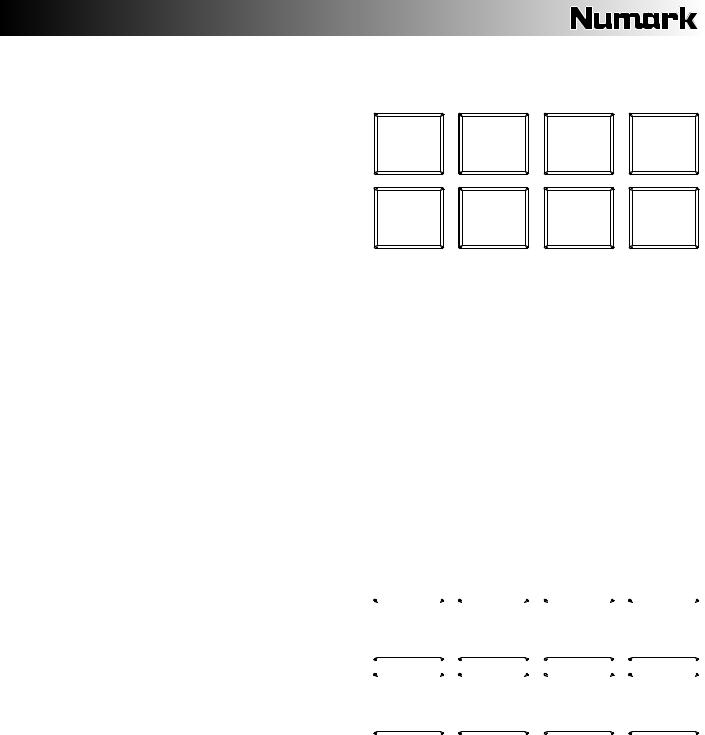
28.Loop: This Pad Mode button switches the pads between two banks in Manual Loop Mode. When the button is unlit, the first press will always select the first bank.
•Manual Loop Mode: Pads 1-4 (the top
row) return the track to one of your |
Manual |
Manual |
Manual |
Manual |
|
Loop 1 |
Loop 2 |
Loop 3 |
Loop 4 |
||
saved Manual Loops. You set and |
|||||
(or 5) |
(or 6) |
(or 7) |
(or 8) |
||
assign a Manual Loop using Pads 5-8 |
|
|
|
|
|
(the bottom row). The pad layouts for |
|
|
|
|
|
the two banks are identical. |
Set |
Set |
Loop |
Reloop |
|
|
Loop In |
Loop Out |
On/Off |
||
|
|
To set a Manual Loop, press any one of Pads 1-4 (the top row) that does not
have a Manual Loop assigned to it. Press Pad 5 to set the Loop In Point, and then press
Pad 6 to set the Loop Out Point and trigger the loop.
To trigger an assigned Manual Loop, press any one of Pads 1-4 (the top row) that has a Manual Loop assigned to it. You can use Pad 7 to activate or deactivate the loop.
Press Pad 8 to return the track to the last triggered Manual Loop and activate it
("reloop").
To delete a Manual Loop, press and hold Shift and then press the corresponding pad
(of Pads 1-4).
Press the Parameter < or Parameter > button to halve or double the Manual Loop's length. Press and hold Shift and then press the Parameter < or Parameter > button to shift the Manual Loop backward or forward.
29.Sampler: This Pad Mode button switches the pads between two modes: Sample Player
Mode and Sample Velocity Trigger Mode). When the button is unlit, the first press will always select Sample Player Mode.
•Sample Player Mode: Pads 1-6 each trigger a sample, which you can assign in the software (the volume level is also set in the software). Unlit pads have no sample assigned to them. Violet pads have a sample assigned but are not triggered. Magenta pads have a sample assigned and are currently playing.
|
Sample 1 |
|
|
Sample 2 |
|
|
Sample 3 |
|
|
|
Sample 4 |
|
|
|
|
|
|
|
|
|
|
|
|
|
|
|
|
|
|
|
|
|
|
|
|
|
|
|
|
Sample 5 |
|
|
Sample 6 |
|
|
no function |
|
|
no function |
|
|
|
|
|
|
|
|
|
|
|
•Sample Velocity Trigger Mode: The pads behave identically to the pads in Sample Player Mode, except they are velocity-sensitive, so triggered samples will play back at a volume level proportional to how heavily you pressed the pads. This mode can give your performance more of a "human feel."
9
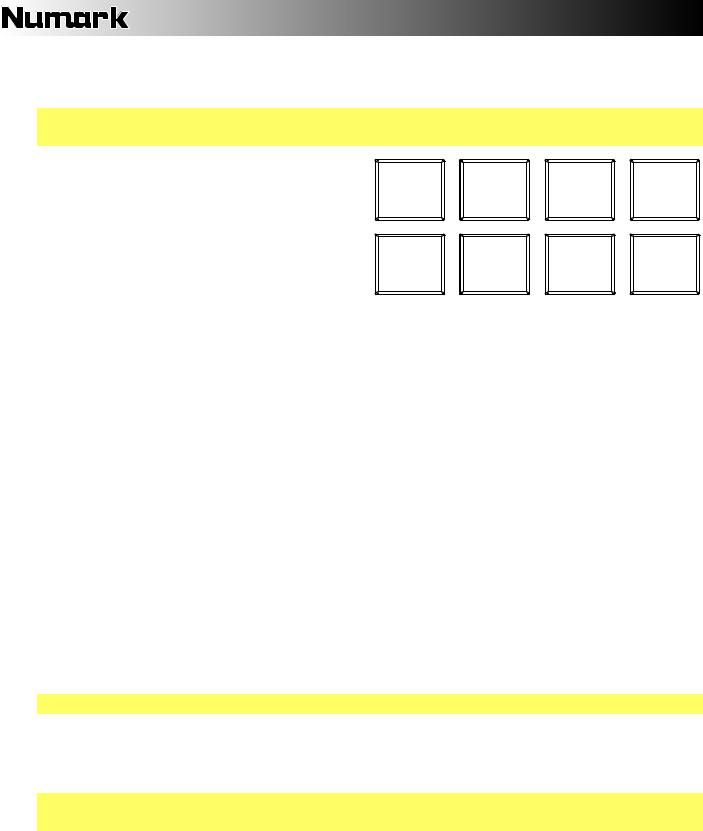
30.Slicer: This Pad Mode button switches the pads between two modes: Slicer Mode and Slicer Loop Mode. When the button is unlit, the first press will always select Slicer Mode.
Important: Your track must have a set Beat Grid for Slicer Mode or Slicer Loop Mode to work.
•Slicer Mode: The eight pads represent
eight sequential beats—"Slices"—in the |
Slice 1 |
Slice 2 |
Slice 3 |
Slice 4 |
|
Beat Grid. The currently playing Slice is |
|
|
|
|
|
represented by the currently lit pad; the |
|
|
|
|
|
light will "move through the pads" as it |
|
|
|
|
|
progresses through each eight-Slice |
Slice 5 |
Slice 6 |
Slice 7 |
Slice 8 |
|
phrase. Press a pad to play that Slice— |
|||||
|
|
|
|
||
hold it down if you want to keep looping |
|
|
|
|
it. When you release the pad, the track will resume normal playback from where it would have been if you had never pressed it (i.e., as if the track had been playing forward the whole time).
Press the Parameter < or Parameter > button to decrease or increase the Slice quantization. Press and hold Shift and then press the Parameter < or Parameter > button to decrease or increase the Slice Domain size.
•Slicer Loop Mode: The pads behave identically to the pads in Slicer Mode, except the eight-Slice phrase will loop rather than moving forward continuously through the track.
Track Controls
31.Strip Search™: The length of this strip represents the length of the entire track. Place your finger on a point along this sensor to jump to that point in the track. (If you want to scroll through a track, we recommend using your computer rather than running your finger along the strip.)
32.Slip / Clear: When using the software's Beat Grid, press and hold this button and move the
Platter to "slip" (i.e., shift or slide) the entire Beat Grid to the left or right.
Press and hold Shift and then press this button to delete the entire Beat Grid.
Important: Your track must have a set Beat Grid for the Slip / Clear button to work.
33.Adjust / Set: Press and hold this button and move the Platter to "warp" the entire Beat Grid.
Press and hold Shift and then press this button to set a Beat Marker at the Audio Pointer's current location.
Important: Your track must have a set Beat Grid for the Adjust feature to work. Also, using the Adjust feature will change the track's BPM.
34.Slip Mode / Motor Off: Press this button to enable or disable Slip Mode. In Slip Mode, you can jump to Hot Cue Points, trigger Loop Rolls, or use the Platters, while the track's timeline continues. In other words, when you stop the action, the track will resume normal playback from where it would have been if you had never done anything (i.e., as if the track had been playing forward the whole time).
Press and hold Shift and press this button to activate or deactivate the corresponding Platter's motor. This will not affect the track's playback.
10

Pitch Controls
35.Tap: Tap this button at the same tempo as the track to help the software detect a more accurate BPM reading.
36.Range / Master Tempo: Press this to adjust the range of the Pitch Fader to ±8%, ±16%, and
±50%.
Press and hold Shift and then press this button to "lock" the track's pitch to its original key. The track's tempo will remain at the speed designated by the Pitch Fader.
37.Takeover LEDs: When you select the other Deck with the Deck Select switch, the position of the NS7II's Pitch Fader may not match the Pitch setting for that Deck in the software. Slowly move the Pitch Fader in the direction indicated by the Takeover LED arrow until it turns off. At this point, the Pitch Fader matches the Pitch setting in the software and can control it again.
38.Pitch Fader: Controls the track's playback speed. An LED next to the fader will light up when set at 0%.
39.Pitch Bend ( + / – ): Press or hold down either of these buttons to temporarily adjust the track's playback speed. When released, the track playback will return to the speed designated by the Pitch Fader.
40.BPM Meter: This meter is an aid for matching the tempo of both decks. When the white center LED is lit, the BPMs are matched. Otherwise, the meter will tend towards the faster deck. The further from center, the greater the difference between the two BPMs.
The meter is also an aid while adjusting Loop In or Loop Out points. If you are making fine adjustments to your Loop In or Loop Out points using the Platters, the lit LED will "wrap around" the meter. It will rest on the white center LED whenever the loop's length has been doubled or halved exactly.
Note: The BPM Meter will aid in loop adjustments only if (1) a BPM reading has been entered for that track and (2) the two Decks' tempos have been synchronized.
Navigation Controls
41.Scroll Knob: Use this knob to scroll through lists of tracks, Crates, etc. in the software. You can also press it to move between the panels shown in the software.
42.Fwd / Back: These buttons move the selector between various panels in the software. Press and hold Shift and then press Fwd to sort the current Library/Crate/Panel View by album. Press and hold Shift and then press Back to sort the current Library/Crate/Panel View by track number.
43.Crates: Press this to move the selector to the Crates Panel in the software. Press and hold Shift and then press this button to sort the current Library/Crate/Panel View by song.
44.Prepare: Press this to move the selector to the Prepare Panel in the software. Press and hold Shift and then press this button to sort the current Library/Crate/Panel View by artist.
45.Files: Press this to move the selector to the Files Panel in the software. Press and hold Shift and then press this button to sort the current Library/Crate/Panel View by BPM.
46.Load A / Load B: Press one of these buttons while a track is selected to assign it to Deck A or Deck B, respectively.
47.Load Prepare: Press this to add a selected track to the list of tracks in the Prepare Panel in the software.
48.Panel / View: Press this to toggle through the Recording (Rec), Effects (FX), and Sampler
(SP-6) panels. Press and hold Shift and then press this button to toggle through the available software display modes (e.g., Vertical, Horizontal, Extended, Library).
11

Effects Controls
49.FX 1, FX 2, FX 3: These buttons have different functions on each Deck depending on the current FX Mode.
•Single-FX Mode: FX 1 activates or deactivates the effect; FX 2 activates or deactivates the first effect parameter; FX 3 activates or deactivates the second effect parameter.
Press and hold Shift and press FX 1 to select the desired effect.
•Multi-FX Mode: The buttons activate or deactivate the first, second, and third effects in the effects chain, respectively. Press and hold Shift and press one of the buttons to select the effect for that point in the effects chain.
50.FX 1 Knob, FX 2 Knob, FX 3 Knob: These knobs have different functions on each Deck depending on the current FX Mode.
•Single-FX Mode: the FX 1 Knob controls the "wet-dry" balance of the effect; the FX 2 Knob controls the first effect parameter; the FX 3 Knob controls the second effect parameter. When Touch Mode is activated, touch the FX 1 Knob to activate its effect, and release the knob to deactivate it.
•Multi-FX Mode: The knobs control the "wet-dry" balance of the first, second, and third effects in the effects chain, respectively. When Touch Mode is activated, touch a knob to activate its effect, and release the knob to deactivate it.
51.Beat / Mode: Tap this button repeatedly at the desired tempo to set the rate of the effects' low-frequency oscillators (LFOs). Press and hold this button to reset Beat Multiplier to the
Deck's BPM. Press and hold Shift and then press this button to switch between Single-FX
Mode and Multi-FX Mode.
52.Beat Knob: Turn this knob to set the Time Division for the selected effects.
53.FX Assign: Use these buttons to apply Effect A and/or B to the corresponding channel. You can apply Effect A and/or B to the entire Program Mix by using the FX Send buttons below the Master Volume knob. (Each effect can be applied to any or all of the four channels and/or the Program Mix.)
54.Channel Filter: Turn this knob to adjust the filter on the corresponding channel. The type of filter it adjusts will depend on the Filter Mode button.
55.Filter Mode: Press this button to change the Filter Mode, which affects the Channel Filter knobs:
•Off: When this button is off, the Channel Filter knob will apply and adjust a low-pass filter to the corresponding channel when turned counter-clockwise or a high-pass filter when turned clockwise.
•Filter-Roll Mode: Press this button once to activate Filter-Roll Mode (the button will light solid red). The Channel Filter knob will apply and adjust a low-pass filter to the corresponding channel when turned counter-clockwise or a high-pass filter when turned clockwise. In addition, it will apply a Loop Roll to the filter and will decrease in length as the knob moves further away from the center position. Press this button once to deactivate Filter-Roll Mode.
•Filter-FX Mode: Press and hold Shift and then press this button to activate Filter-FX Mode (the button will flash red). The Channel Filter knob will apply and adjust a lowpass filter to the corresponding channel when turned counter-clockwise or a high-pass filter when turned clockwise. In addition, it will adjust Parameter 1 of the effects applied to that channel as the knob moves further away from the center position. Press this button once to deactivate Filter-FX Mode.
12

Front Panel
 7
7

9 |
10 11 |
8 |
5 |
5 |
6 |
5 |
5 |
4 |
3 |
2 |
1 |
1 |
1.Headphones (1/4" or 1/8"): Connect your 1/4" or 1/8" headphones to this output for cueing and mix monitoring.
2.Headphone Volume: Adjusts the volume level of the headphone output.
3.Split Cue: When this switch is in the On position, the headphone audio will be "split" such that all channels sent to Cue are mixed to mono and applied to the left headphone channel and the Program mix is mixed to mono and applied to the right channel. When the switch is in the Off position, Cue and Program audio will be "blended" together.
4.Cue Blend: Turn to mix between Cue and Program in the Headphone channel. When all the way to the left, only channels routed to Cue will be heard. When all the way to the right, only the Program mix will be heard.
5.Crossfader Assign: Routes the audio playing on the corresponding channel to either side of the crossfader (A or B), or bypasses the crossfader and sends the audio directly to the Program Mix (center, Off).
6.Crossfader Slope: Adjusts the slope of the crossfader curve. Turn the knob to the left for a smooth fade (mixing) or to the right for a sharp cut (scratching). The center position is a typical setting for club performances.
7.Mic 1 Input (1/4"): Connect a 1/4" microphone to this input. This input's audio signal is routed directly to the Program Mix and Cue Mix.
8.Mic 1 On/Off: When set to On, the Mic 1 Input is active, and its audio signal is routed directly to the Program Mix and Cue Mix. When set to Off, the Mic 1 Input is disabled.
9.Mic Gain: Adjusts the gain of the microphone channel.
10.Mic Bass: Adjusts the low (bass) frequencies of the audio signal coming from the microphone input.
11.Mic Treble: Adjusts the high (treble) frequencies of the audio signal coming from the microphone input.
13
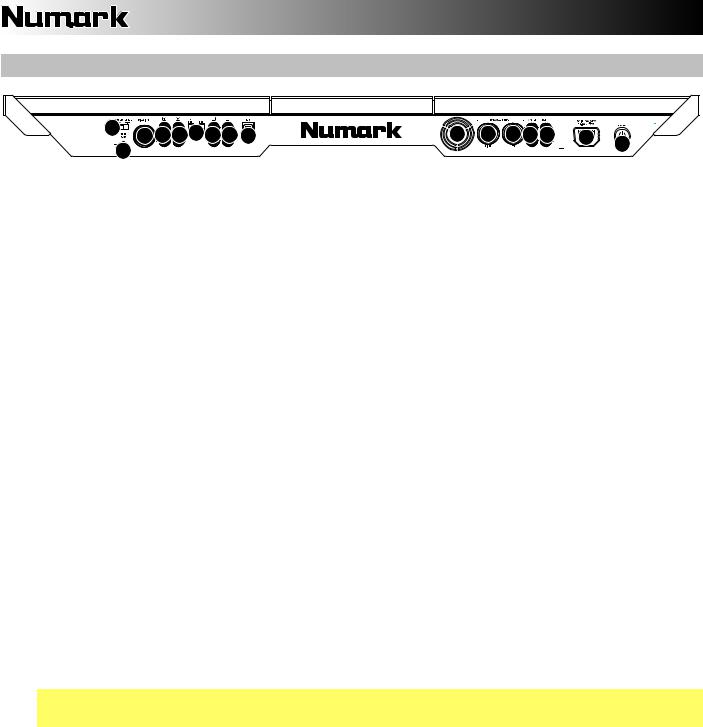
Rear Panel
12 |
9 |
7 |
8 |
7 |
9 |
3 |
11 |
||||||
10 |
|
|
|
|
|
|
13 |
4 |
4 |
5 |
6 |
1 |
2 |
|
|
|
|
|
|
1.Power In: Use the included power cable to connect NS7II to a power outlet. While the power is switched off, plug the cable into NS7II first, then plug the cable into a power outlet.
2.Power Switch: Turns NS7II on and off. Turn on NS7II after all input devices have been connected and before you turn on amplifiers. Turn off amplifiers before you turn off NS7II.
3.USB: This USB connection sends and receives audio and control information from a connected computer.
4.Master Output (XLR): Connect this low-impedance XLR output to a PA system or powered monitors. The level of this output is controlled with the Master knob on the top panel.
5.Master Output (RCA): Use standard RCA cables to connect this output to a speaker or amplifier system. The level of this output is controlled by the Master knob on the top panel.
6.Booth Output (RCA): Use standard RCA cables to connect this output to a booth monitoring system. The level of this output is controlled by the Booth knob on the top panel.
7.Line/Phono Inputs (RCA): Connect your audio sources to these inputs. These inputs can accept both line and phono-level signals.
8.Line/Phono Switch: Flip this switch to the appropriate position, depending on the device connected to the Line/Phono Inputs. If you are using phono-level turntables, set this switch to Phono to provide the additional amplification needed for phono-level signals. If using a linelevel device, such as a CD player or sampler, set this switch to Line.
9.Line Inputs (RCA): Connect line-level devices, such as CD players, samplers or audio interfaces, to these inputs.
10.Grounding Terminal: If using phono-level turntables with a grounding wire, connect the grounding wire to these terminals. If you experience a low "hum" or "buzz", this could mean that your turntables are not grounded.
Note: Some turntables have a grounding wire built into the RCA connection and, therefore, nothing needs to be connected to the grounding terminal.
11.Mic 2 Input (1/4"): Connect a 1/4" microphone to this input. Microphone controls are located on the top panel on any channel whose Input Selector is set to Mic2.
12.Motor Torque: Flip this switch to adjust the torque of the Platters. At the high setting, the Platters will have the heavier, stronger feel of "modern" turntables. At the lower setting, they are lighter and more graceful – the feel of a "classic" turntable.
13.Cooling Fan: Keep the area in front of this vent clear from obstructions. The fan behind the vent cools the NS7II, preventing overheating.
14

Guía del usuario (Español)
Introducción
Contenido de la caja
•NS7II
•2 conjuntos de plato:
o Plato de aluminio
o Alfombrilla
o Vinilo
oAdaptador de 45 rpm (fijado)
•Cable de alimentación IEC
•Cable USB
•Tornillo del eje central
•Llave Allen
•Software Serato DJ (descargado)
•Guía de inicio rápido
•Guía del usuario
•Manual sobre la seguridad y garantía
Registro y soporte del producto
Para obtener la información más reciente acerca de este product (los requisitos completos de sistema, la compatibilidad, etc) y el registro del producto, visite numark.com/ns7ii.
Para soporte adicional del producto, visite numark.com/support.
Inicio rápido
ANTES DE EMPEZAR:
•Lea el Manual sobre la seguridad y garantía antes de usar el NS7II.
•Asegúrese de que estén presentes todos los elementos enumerados en Contenido de la caja.
1. Arme los platos
1. Retire el NS7II del embalaje. Retire los dos conjuntos |
Paso 2 |
|
|
de plato del embalaje (están debajo del controlador |
|
NS7II). Coloque el NS7II sobre una superficie plana y |
|
estable para hacerlo funcionar. Asegúrese de que la |
|
unidad tenga un flujo de aire adecuado en todas las |
|
aberturas de ventilación (especialmente si se instala |
|
dentro de una caja). |
|
2. Coloque el plato en el NS7II alineando los pernos de la parte inferior del plato con los orificios del motor.
3.Coloque la alfombrilla sobre el plato y luego el vinilo sobre la alfombrilla.
4.Alinee la muesca del eje con el tornillo del adaptador de 45 RPM del vinilo. Use la llave Allen (incluida) para apretar el tornillo, sujetando así el adaptador en el eje.
Paso 3
Paso 4
15
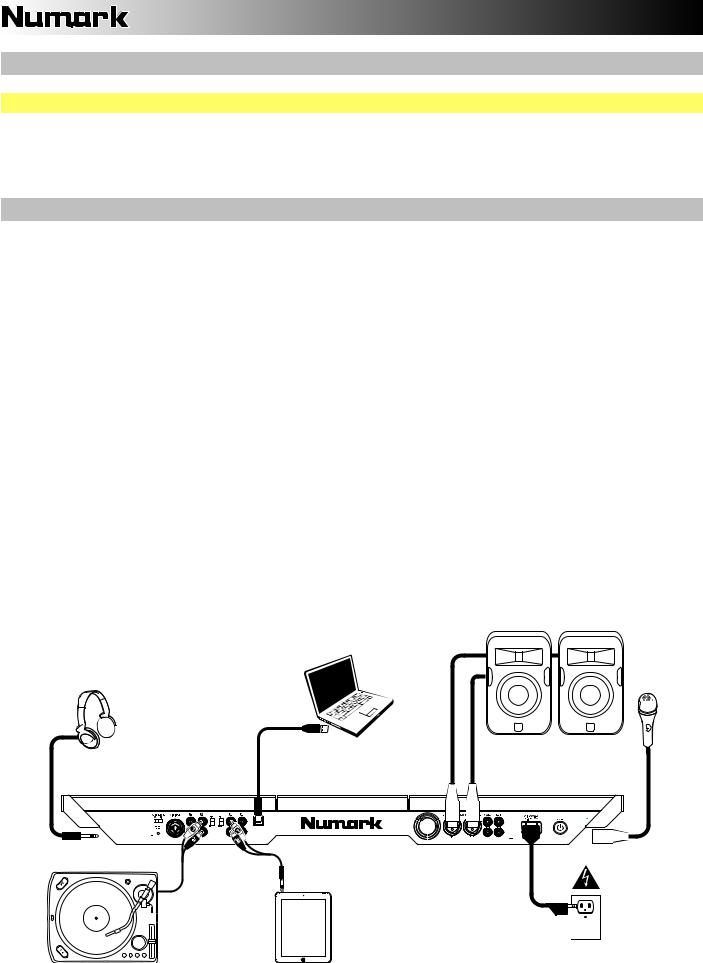
2. Instale los drivers y el software
IMPORTANTE: Instale los drivers antes de instalar el software.
Drivers: Descargue y instale los drivers más recientes de numark.com/ns7ii. (El sistema le solicitará que conecte el NS7II a la computadora durante la instalación).
Software: Descargue y instale la versión más reciente de Serato DJ de serato.com.
3. ¡Conecte y sea el DJ!
Siga esta secuencia de pasos toda vez que use NS7II:
1.Asegúrese de que todos los dispositivos estén apagados y que todos los faders y perillas de ganancia estén ajustados a "cero".
2.Conecte al NS7II las fuentes de entrada (micrófonos, giradiscos, reproductores de CD, etc.) al NS7II.
3.Conecte al NS7II los dispositivos de salida (amplificadores de potencia, submezclador, grabadores, etc.).
4.Enchufe todos los dispositivos a las fuentes de alimentación y enciéndalos en el orden correcto:
•Para iniciar la sesión, encienda (1) las fuentes de entrada, (2) el NS7II, (3) los dispositivos de salida.
•Al terminar la sesión, invierta esta operación apagando (1) los dispositivos de salida, (2) el NS7II y (3) las fuentes de entrada.
5.Conecte el NS7II a la computadora con el cable USB (incluido) y a sus auriculares.
6.¡Abra el software Serato DJ y allá va! Para más información acerca de cómo usar Serato DJ con NS7II, visite serato.com/dj/support y seleccione Numark NS7II.
Diagrama de conexión (ejemplo): |
Altavoces activos |
|
Computadora |
Auriculares
 (al panel frontal)
(al panel frontal)
Micrófono
(al panel frontal)
Alimentación 

|
00.0% |
Giradiscos |
Tableta, reproductor de MP3, etc |
Todos los elementos que se muestran en la ilustración pero no se mencionan en Contenido de la caja se venden por separado.
16
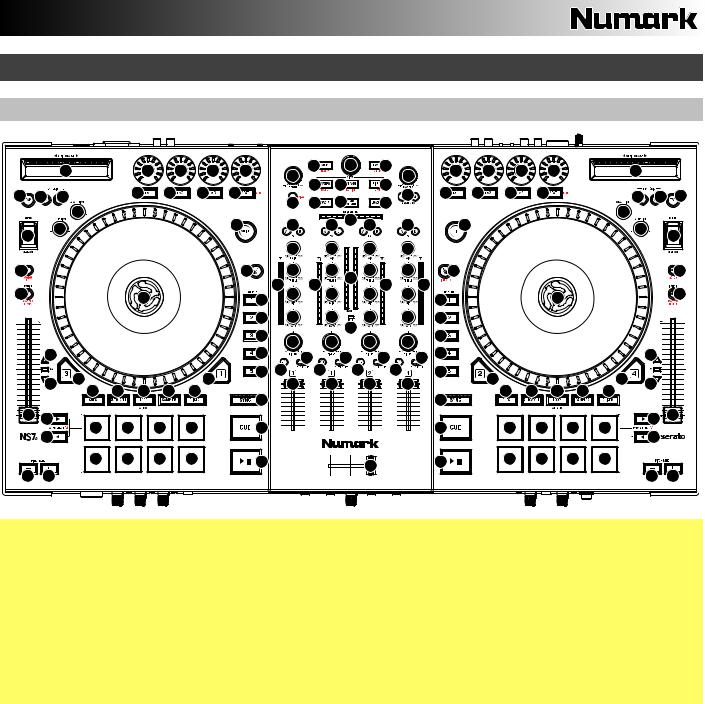
Características
Panel superior
|
|
31 |
|
|
50 |
50 |
50 |
52 |
|
42 |
|
41 |
|
42 |
|
50 |
50 |
50 |
52 |
|
|
31 |
|
|
||
|
|
|
|
15 |
|
|
|
|
14 |
|
|
|
|
|
||||||||||||
|
|
|
|
|
|
|
|
|
|
|
|
|
|
|
|
|
|
|
|
|
|
|
|
|
||
|
|
|
|
|
|
|
|
|
|
|
43 |
44 |
|
45 |
|
|
|
|
|
|
|
|
|
|
|
|
35 |
ADJUST |
SLIP |
|
49 |
49 |
49 |
51 |
|
|
|
|
|
53 |
|
49 |
49 |
49 |
51 |
|
|
ADJUST |
SLIP |
35 |
|||
33 |
32 |
|
|
|
|
|
|
|
PANEL |
46 |
47 |
|
|
|
|
|
|
|
|
|
33 |
32 |
||||
|
SET |
CLEAR |
|
|
|
|
|
|
|
48 |
|
46 |
|
|
|
|
|
|
|
|
SET |
CLEAR |
|
|||
|
17 |
|
|
|
|
|
|
|
|
|
|
|
|
|
|
|
|
|
|
|
17 |
|
||||
|
|
|
|
|
|
|
|
|
|
|
|
|
|
|
|
|
|
|
|
|
|
|
|
|
||
|
|
18 |
|
|
|
|
|
|
1 |
53 |
|
53 |
40 |
53 |
53 |
|
1 |
|
|
|
|
|
|
18 |
|
|
|
|
|
|
|
|
|
|
|
|
|
|
|
|
|
|
|
|
|
|
|
|
|
|
|
||
22 |
|
|
|
|
|
|
|
|
|
|
|
|
|
|
|
|
|
|
|
|
|
|
|
|
|
22 |
|
|
|
|
|
|
|
|
|
|
6 |
|
6 |
|
6 |
6 |
|
|
|
|
|
|
|
|
|
|
|
SLIP |
|
|
|
|
|
|
|
|
TOUCH |
|
|
|
|
|
|
|
FILTER ROLL |
|
|
|
|
|
|
|
|
SLIP |
MODE |
|
|
|
|
|
|
|
|
|
|
|
|
|
|
|
|
|
|
|
|
|
|
|
MODE |
||
34 |
|
|
|
|
|
|
|
|
2 |
8 |
|
8 |
|
8 |
8 |
|
55 |
|
|
|
|
|
|
|
|
34 |
|
|
|
|
|
|
|
|
|
TOUCH LOCK |
7 |
7 |
|
7 |
|
7 |
7 |
|
|
|
|
|
|
|
|
|
|
36 |
|
|
|
|
16 |
|
|
|
23 |
9 |
|
9 |
|
9 |
9 |
|
23 |
|
|
|
16 |
|
|
|
|
36 |
|
|
|
|
|
|
|
|
|
|
|
|
|
|
|
|
|
|
|
|
|
|
|
||||
|
|
|
|
|
|
|
|
|
|
|
|
|
|
|
|
|
|
|
|
|
|
|
|
|
||
|
|
|
|
|
|
|
|
|
23 |
10 |
|
10 |
|
10 |
10 |
|
23 |
|
|
|
|
|
|
|
|
|
|
|
|
|
|
|
|
|
|
|
|
|
|
4 |
|
|
|
|
|
|
|
|
|
|
|
|
|
|
|
|
|
|
|
|
|
|
23 |
|
|
|
|
|
|
|
23 |
|
|
|
|
|
|
|
|
|
|
|
|
|
|
|
|
|
|
|
54 |
|
54 |
|
54 |
54 |
|
|
|
|
|
|
|
|
|
|
|
|
37 |
|
|
|
|
|
|
23 |
|
5 |
|
5 |
|
5 |
5 |
23 |
|
|
|
|
|
|
37 |
|
||
|
|
|
|
|
|
|
|
|
23 |
12 |
12 |
|
12 |
|
12 |
|
23 |
|
|
|
|
|
|
|
|
|
|
37 |
3 |
|
|
|
|
3 |
|
11 |
|
11 |
|
11 |
11 |
|
|
3 |
|
|
|
|
3 |
37 |
|
||
|
|
|
|
|
|
|
|
|
|
|
|
|
|
|
|
|
|
|
||||||||
|
|
|
26 |
27 |
28 |
29 |
30 |
|
|
|
|
|
|
|
|
|
|
|
26 |
27 |
28 |
29 |
30 |
|
|
|
|
|
|
|
|
|
|
|
|
21 |
|
|
|
|
|
|
|
21 |
|
|
|
|
|
|
|
|
|
|
|
|
|
|
|
|
|
|
SYNC OFF |
|
|
|
|
|
|
|
SYNC OFF |
|
|
|
|
|
|
|
|
|
38 |
25 |
|
|
|
|
|
|
|
|
|
|
|
|
|
|
|
|
|
|
|
|
|
|
|
25 |
38 |
|
|
|
24 |
24 |
|
24 |
24 |
|
20 |
|
|
|
|
|
|
|
20 |
|
24 |
24 |
|
24 |
24 |
|
|
|
|
25 |
|
|
|
|
|
|
|
|
|
|
|
|
|
|
|
|
|
|
|
|
|
|
|
25 |
|
|
|
|
24 |
24 |
|
24 |
24 |
|
19 |
|
|
|
|
|
|
|
19 |
|
24 |
24 |
|
24 |
24 |
|
|
|
|
|
|
|
|
|
|
|
|
|
|
|
|
13 |
|
|
|
|
|
|
|
|
|
|
|
||
|
|
|
|
|
|
|
|
|
|
|
|
|
|
|
|
|
|
|
|
|
|
|
|
|
|
|
39 |
39 |
|
|
|
|
|
|
STUTTER |
|
|
|
|
|
|
|
STUTTER |
|
|
|
|
|
|
39 |
39 |
||
Términos útiles: |
|
|
|
|
|
|
|
|
|
|
|
|
|
|
|
|
|
|
|
|
|
|
||||
Puntero de audio: Posición actual de la pista desde donde se reproduce el audio. Cuando usted selecciona una pista y comienza a reproducir, el puntero de audio arranca habitualmente al comienzo y se detiene al final.
Punto de cue rápido: Posición marcada en una pista, que el software almacena permanentemente. Es posible establecer, volver o eliminar puntos de cue rápido con los controles de cue rápido.
Punto de cue temporal:Posición marcada en la pista que permanece sólo mientras la pista está cargada en la bandeja. Es posible establecer y volver al punto de cue temporal con el botón Cue.
Controles generales
1.Función secundaria: Mantenga pulsado este botón para acceder a las funciones secundarias (en letra roja) de los demás controles del NS7II.
2.Modo táctil: Mantenga pulsado este botón para acceder a las funciones capacitivas táctiles de las perillas FX 1, FX 2 y FX 3 del NS7II.
Mantenga pulsado Shift (botón de función secundaria) y pulse este botón para acceder a las funciones capacitivas táctiles de las mismas perillas de arriba más las perillas del ecualizador (agudos de canal, medios de canal y bajos de canal). Estas funciones son momentáneas, no de "enganche".
3.Bandeja virtual: Se usa para seleccionar qué bandeja virtual del software es controlada por esa bandeja del hardware. La bandeja A puede controlar las bandejas virtuales 1 ó 3. La bandeja B puede controlar las bandejas virtuales 2 ó 4.
4.Indicador USB: Este LED se enciende cuando el NS7II se conecta exitosamente y se comunica con su computadora.
17
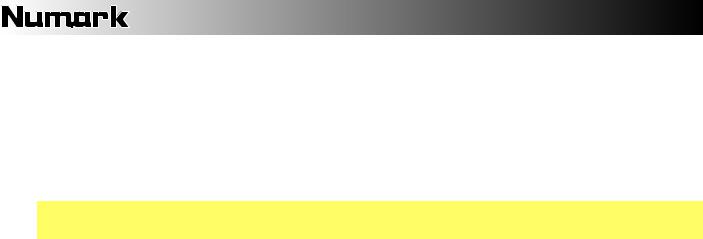
Controles del mezclador
5.Selector de entrada: Coloque este interruptor según la fuente de audio deseada desde este canal: PC (un pista que se reproduce en esa capa en el software), Mic 2 o Line (Línea) (un dispositivo conectado a la entrada Mic 2 (Micrófono 2) o Line (Línea) del panel trasero del
NS7II). Tenga en cuenta que los interruptores selectores Line/Phono del panel trasero también se deben colocar correctamente. Asimismo, los controles de un canal solo envían información MIDI cuando su selector de entrada se coloca en PC.
Importante: No coloque más de un selector de entrada de canal en Mic2, puesto que puede causar una realimentación o distorsión indeseable.
6.Ajuste de ganancia: Ajusta el nivel de audio previo al fader y al ecualizador del canal correspondiente en el software.
7.Medidores con LED: Monitorean el nivel de audio de la salida de programa en el canal correspondiente.
8.Treble (de canal): Ajusta las altas frecuencias (agudos) del audio que se reproduce en el canal correspondiente.
9.Medios (de canal): Ajusta las frecuencias medias del audio que se reproduce en el canal correspondiente.
10.Graves (de canal): Ajusta las bajas frecuencias (graves) del audio que se reproduce en el canal correspondiente.
11.Fader canal: Ajusta el nivel de audio del canal correspondiente en el software.
12.PFL: Pulse este botón para enviar esta señal de nivel pre-fader al canal de cue para monitoreo. Cuando está pulsado, el botón se enciende. Al pulsar un botón PFL a la vez, hace cue en ese canal solamente (y desactiva el monitoreo de PFL de los demás canales).
Para hacer cue en varios canales simultáneamente, pulse los botones PFL de esos canales al mismo tiempo.
13.Crossfader: Combina el audio entre los canales asignados a los lados izquierdo y derecho del crossfader.
14.Volumen maestro: Ajusta el volumen de salida de la mezcla de programa.
15.Volumen cabina (booth): Ajusta el volumen de salida de la mezcla de salida para cabina (Booth Output).
Controles de la reproducción
16.Plato: Controla el puntero de audio en el software.
17.Tiempo de arranque: Controla el tiempo en el cual el plato retoma su velocidad de reproducción normal.
18.Tiempo de parada: Controla el tiempo en que el plato aminora su velocidad hasta detenerse por completo ("tiempo de frenado").
19.Reproducir/Pausa: Con este botón se pone en pausa o reanuda la reproducción.
Mantenga pulsado Shift y pulse este botón para que la pista "tartamudee" desde el último punto de cue.
20.Cue: Cuando la bandeja se pone en pausa, puede establecer un punto de cue temporal moviendo el plato para colocar el puntero de audio en el lugar deseado y pulsando luego el botón Cue.
18
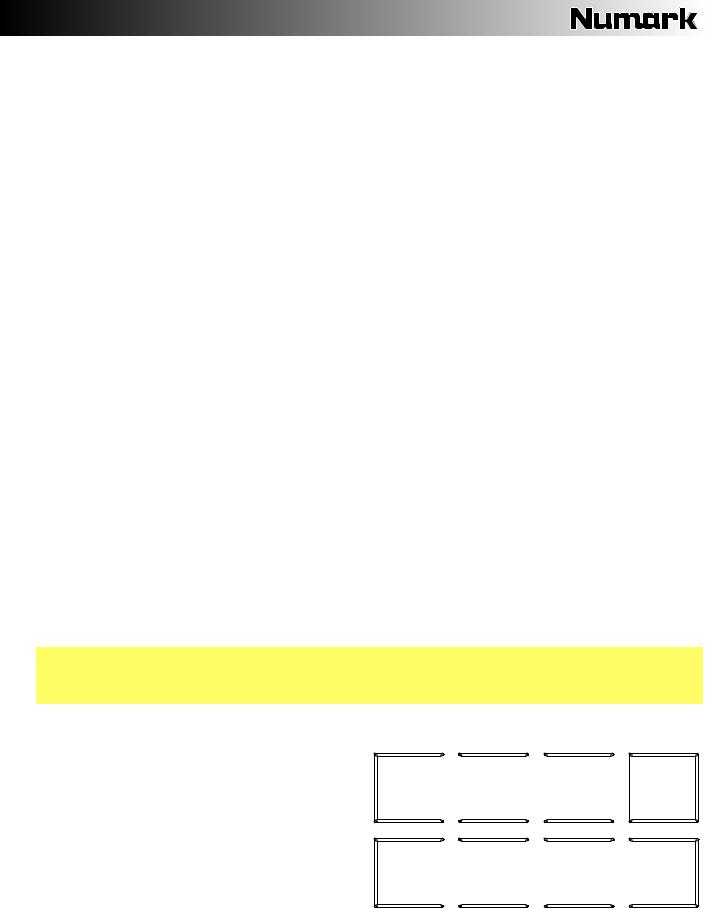
Durante la reproducción, puede pulsar el botón Cue para que la pista vuelva a este punto de cue temporal. (Si no estableció un punto de cue temporal, volverá al principio de la pista.)
Si la bandeja está en pausa, puede mantener pulsado el botón Cue para reproducir la pista desde el punto de cue temporal. Al soltar el botón Cue, la pista vuelve al punto de cue temporal y se pone en pausa. Para continuar la reproducción sin volver al punto de cue temporal, mantenga pulsado el botón Cue, luego mantenga pulsado el botón de reproducir y luego suelte ambos botones.
Mantenga pulsado Shift y pulse este botón para volver al comienzo de la pista.
21.Sincronismo: Pulse este botón para hacer coincidir automáticamente el tempo de la bandeja correspondiente con el tempo y la fase de la bandeja opuesta. Mantenga pulsado
Shift y pulse este botón para desactivar el sincronismo.
22.Bleep / Reversa: Invierte la reproducción de audio de la pista en la bandeja correspondiente.
Cuando el interruptor está en la posición Reverse, se invierte la reproducción de la pista. Al regresar el conmutador a la posición central (desactivado) se reanuda la reproducción normal desde el punto en que se detuvo el puntero de audio.
Cuando el interruptor se mantiene en la posición Bleep, se invierte la reproducción de la pista. Al volver el conmutador a la posición central (desactivado), se reanuda la reproducción normal desde donde lo haría si nunca se hubiera activado la función Bleep (es decir, si la pista se hubiera estado reproduciendo hacia adelante todo el tiempo).
Controles de cue
23.Botones de cue rápido (1-5): Asignan un punto de cue rápido o regresan la pista a ese punto de cue rápido. Cuando un botón cue rápido está apagado, puede asignar un punto de cue rápido pulsándolo en el punto deseado de su pista. Una vez asignado, el botón cue rápido se enciende. Para volver a ese punto de cue rápido, simplemente púlselo.
Pulse y mantenga pulsado el botón Shift y pulse el botón hot cue apropiado para eliminar el punto de cue rápido asignado.
Consejo: Si la bandeja está en pausa, al mantener pulsado un botón cue rápido encendido, la reproducción comienza desde ese punto de cue rápido. Al soltarlo, la pista regresa a ese punto de cue rápido y se pone la reproducción en pausa.
Controles de modo de pad
24.Pads: Estos pads tienen distintas funciones en cada bandeja en función del modo de pad activado. Son los mismos usados en los MPC Akai Professional, de modo que son sensibles a la velocidad (solo en algunos modelos), durables y fáciles de tocar.
En esta sección, cuando hagamos referencia a pads específicos, utilizaremos los números que se muestran en el diagrama de la derecha.
1 


 2
2 


 3
3 


 4
4
5 


 6
6 


 7
7 


 8
8
25.Parámetro < / >: Use estos botones para diversas funciones en cada modo de pad
(explicado abajo).
19
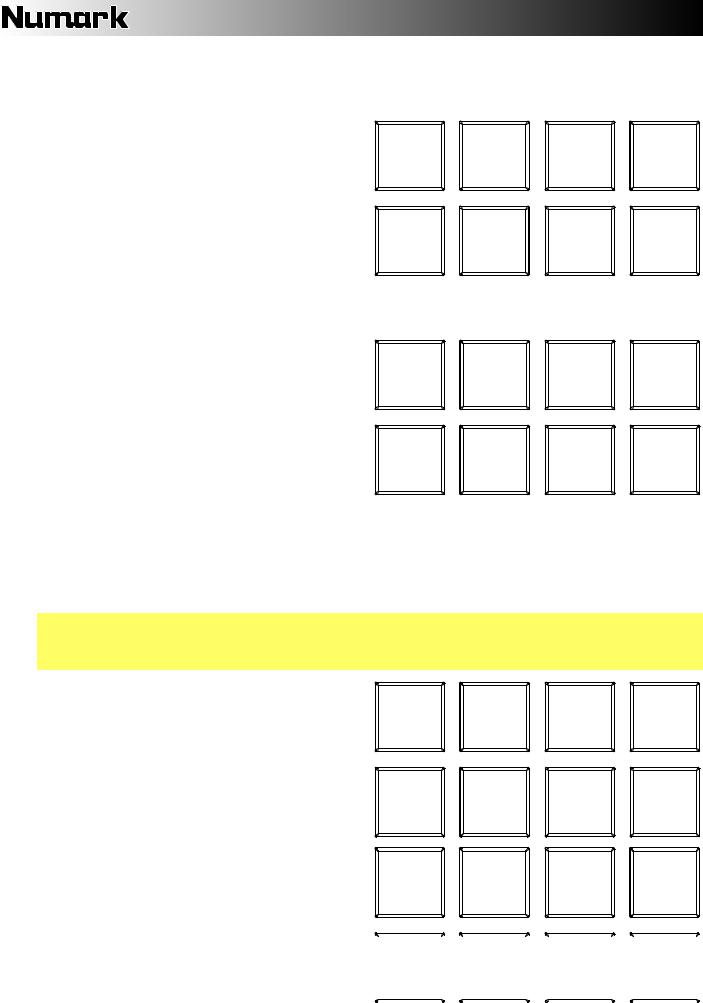
26.Cues: Este botón de modo de pad cambia los pads entre dos modos: Modo de Hot Cue (Cue rápido) (rojo) y loop automático con cue rápido (naranja). Cuando el botón está apagado, la primera pulsación selecciona siempre el modo de cue rápido.
• Modo de cue rápido: Cada pad asigna |
|
|
|
|
un punto de cue rápido o hace que la |
Cue rápido |
Cue rápido |
Cue rápido |
Cue rápido |
pista vuelva a ese punto de cue rápido. |
1 |
2 |
3 |
4 |
(Los pads 1 a 5 son esencialmente |
|
|
|
|
duplicados de los botones de cue rápido |
|
|
|
|
1 a 5.) Cuando un botón Hot Cue está |
Cue rápido |
Cue rápido |
Cue rápido |
Cue rápido |
apagado, puede asignar un punto de |
||||
cue rápido pulsándolo en el punto |
5 |
6 |
7 |
8 |
|
|
|
|
|
deseado de su pista. Una vez asignado, |
|
|
|
|
el botón Hot Cue se enciende. Mantenga pulsado Shift y pulse un pad para eliminar su punto de cue rápido asociado.
•Modo de loop automático con cue
rápido: Cada pad asigna un punto de cue rápido o hace que la pista vuelva a ese punto de cue rápido pero, en ambos, casos, crea también un loop automático en ese punto. La longitud de los loops automáticos se configura en el software, pero usted puede aumentarla o reducirla con el botón Parameter < o
Parameter >.
Cue rápido |
Cue rápido |
Cue rápido |
Cue rápido |
1 + loop |
2 + loop |
3 + loop |
4 + loop |
automático |
automático |
automático |
automático |
Cue rápido |
Cue rápido |
Cue rápido |
Cue rápido |
5 + loop |
6 + loop |
7 + loop |
8 + loop |
automático |
automático |
automático |
automático |
27.Auto / Regreso: Este botón de modo de pad cambia los pads entre dos modos: Loop automático (azul oscuro) y loop con regreso (celeste). Cuando el botón está apagado, la primera pulsación selecciona siempre el modo de loop automático.
Nota: Estas disposiciones de pads coinciden con el esquema de división de tiempo de loop automático por defecto. Si desplaza el rango de divisiones de tiempo mostrado en el software, la disposición del pad cambia para coincidir con él.
•Modo de loop automático: Cada pad
dispara o libera un loop automático de una longitud diferente. Mantenga pulsado Shift y pulse el botón Parameter < o Parameter > para desplazar el loop automático hacia atrás o adelante.
•Modo de loop con regreso: Cada pad
dispara un loop con regreso momentáneo. Pulse el botón Parameter
< o Parameter > para cambiar la división de tiempo del loop con regreso.
Loop |
Loop |
Loop |
Loop |
automático |
automático |
automático |
automático |
de 1/8 beat |
de 1/4 beat |
de 1/2 beat |
de 1 beat |
Loop |
Loop |
Loop |
Loop |
automático |
automático |
automático |
automático |
de 2 beats |
de 4 beats |
de 8 beats |
de 16 beats |
Loop con |
Loop con |
Loop con |
Loop con |
regreso de |
regreso de |
regreso de |
regreso de |
1/8 beat |
1/4 beat |
1/2 beat |
1 beat |
|
Loop con |
|
|
Loop con |
|
|
Loop con |
|
|
Loop con |
|
regreso de |
|
|
regreso de |
|
|
regreso de |
|
|
regreso de |
|
2 beats |
|
|
4 beats |
|
|
8 beats |
|
|
16 beats |
|
|
|
|
|
|
|
|
|
|
|
20
